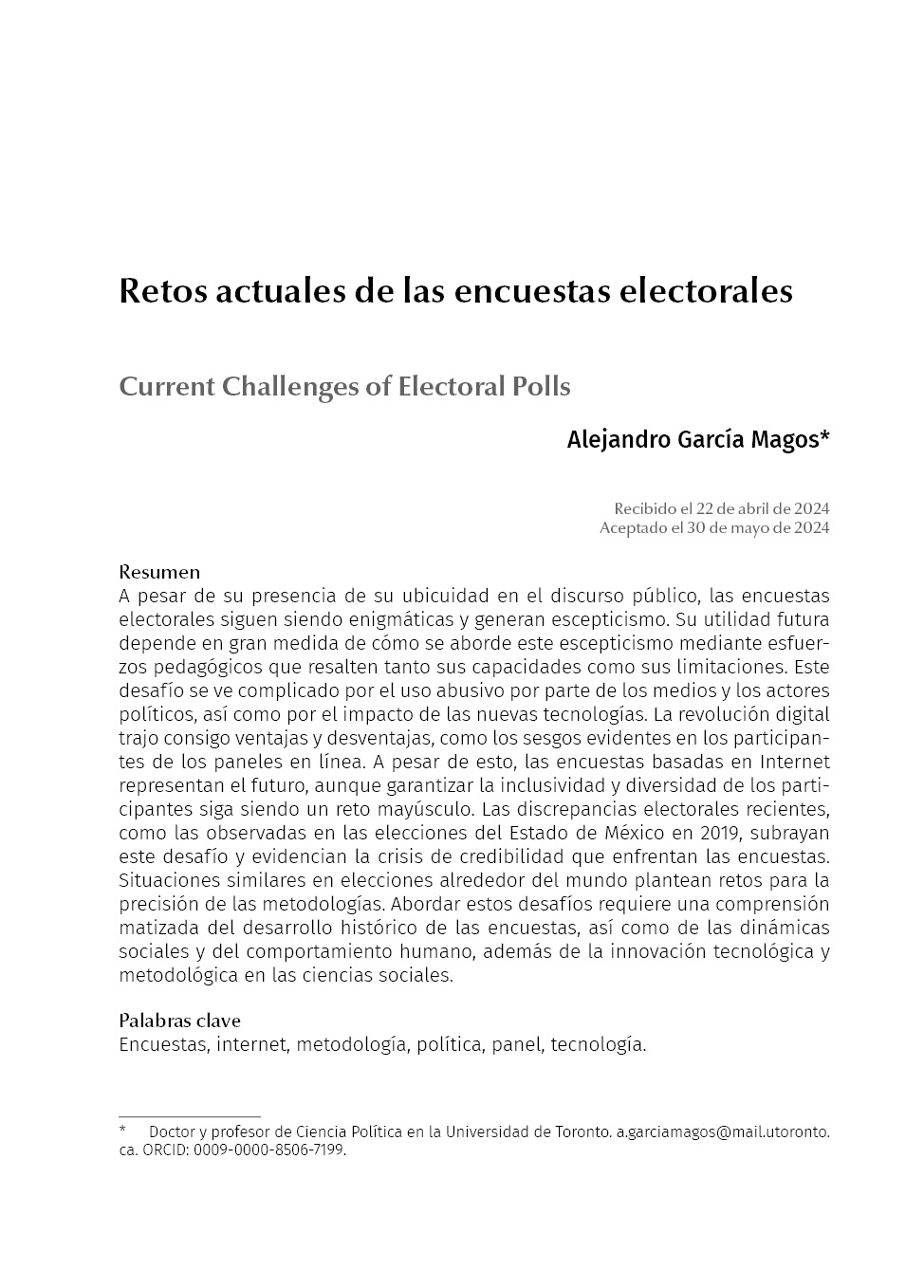Retos actuales de las encuestas electorales
Contenido principal del artículo
Resumen
A pesar de su ubicuidad en el discurso público, las encuestas electorales siguen siendo enigmáticas y generan escepticismo. Su utilidad futura depende en gran medida de cómo se aborde este escepticismo mediante esfuerzos pedagógicos que resalten tanto sus capacidades como sus limitaciones. Este desafío se ve complicado por el abusivo uso por parte de los medios y de los actores políticos, así como por el impacto de las nuevas tecnologías. La revolución digital trajo consigo ventajas y desventajas, como los sesgos evidentes en los participantes de los paneles en línea. A pesar de esto, las encuestas basadas en Internet representan el futuro, aunque garantizar la inclusividad y diversidad de los participantes siga siendo un reto mayúsculo. Las discrepancias electorales recientes, como las observadas en las elecciones del Estado de México en 2019, subrayan este desafío y evidencian la crisis de credibilidad que enfrentan las encuestas. Situaciones similares en elecciones alrededor del mundo plantean retos para la precisión de las metodologías. Abordar estos desafíos requiere una comprensión matizada del desarrollo histórico de las encuestas, así como de las dinámicas sociales y del comportamiento humano, además de la innovación tecnológica y metodológica en las ciencias sociales.
Detalles del artículo
Citas en Dimensions Service
Citas
Amber, H. y Chichaibelu, B. B. (2023). Narrowing the gender digital divide in Pakistan: Mobile phone ownership and female labor force participation. Review of Development Economics, 27(3), 1354-1382. https://doi.org/10.1111/rode.12994
Andrews, D., Nonnecke, B. y Preece, J. (2007). Conducting research on the internet: Online survey design, development and implementation guidelines. International Journal of Human-Computer Interaction, 16(2), 185-210.
Benjamin, E. O., Hall, D., Sauer, J. y Buchenrieder, G. (2022). Are carbon pricing policies on a path to failure in resource-dependent economies? A willingness-to-pay case study of Canada. Energy Policy, 162, 112805. https://doi.org/10.1016/j.enpol.2022.112805
Bennetts, S. K., Hokke, S., Crawford, S., Hackworth, N. J., Leach, L. S., Nguyen, C. Nicholson, J. M. y Cooklin, A. R. (2019). Using paid and free Facebook methods to recruit Australian parents to an online survey: an evaluation. Journal of Medical Internet Research, 21(3), e11206. https://doi.org/10.2196/11206
Callegaro, M., Baker, R., Bethlehem, J., Göritz, A. S., Krosnick, J. A. y Lavrakas, P. J. (2014). Online panel research. Online Panel Research: Data Quality Perspective, A, 1-22. https://doi.org/10.1002/9781118763520.ch1
Cantor, D. (2008). A review and summary of studies on panel conditioning. Handbook of longitudinal research: Design, measurement, and analysis, 123-138.
Castorena, O., Lupu, N., Schade, M. y Zechmeister, E. J. (2023). Online Surveys in Latin America. PS: Political Science & Politics, 56(2), 273-280. https://doi.org/10.1017/S1049096522001287
Procuraduría Federal del Consumidor. (2020). Evolución y Cambio en Oferta de Servicios Telecomunicaciones. Gobierno de México-Profeco. https://www.gob.mx/cms/uploads/attachment/file/551880/Evolucion_y_Cambio_en_oferta_de_servicios_de_Telecomunicaciones_Profeco.pdf
Halpern-Manners, A., Warren, J. R. y Torche, F. (2017). Panel conditioning in the general social survey. Sociological Methods & Research, 46(1), 103-124. https://doi.org/10.1177/0049124114532445
Gande, S., Mangal, R. K., Stead, T. S. y Ganti, L. (2023). State of nutrition amongst US college students: dataset of a national survey study. BMC Research Notes, 16(1), 10. https://doi.org/10.1186/s13104-023-06273-7
García Magos, A. (1 de abril de 2024). Instrucciones para leer encuestas. Diez puntos a considerar. Revista Este País. https://estepais.com/tendencias_y_opiniones/instrucciones-para-leer-encuestas/
Groves, R. M. (2011). Three eras of survey research. Public opinion quarterly, 75(5), 861-871.
Iida, T., Song, J., Estrada, J. L. y Takahashi, Y. (2022). Fake news and its electoral consequences: a survey experiment on Mexico. Ai & Society, 1-14. https://doi.org/10.1007/s00146-022-01541-9
Likert, R. (1932). A technique for the measurement of attitudes. Archives of psychology, 22(140), 1-55.
Meng, X. L. (2018). Statistical paradises and paradoxes in big data (i) law of large populations, big data paradox, and the 2016 us presidential election. The Annals of Applied Statistics, 12(2), 685-726.
Neyman, J. (1934). On the Two Different Aspects of the Representative Method: The Method of Stratified Sampling and the Method of Purposive Selection. Journal of the Royal Statistical Society, 97, 558-606. https://doi.org/10.2307/2342192
Piltch-Loeb, R., Harriman, N. W., Healey, J., Bonetti, M., Toffolutti, V., Testa, M. A., Su, M. y Savoia, E. (2021). COVID-19 vaccine concerns about safety, effectiveness, and policies in the United States, Canada, Sweden, and Italy among unvaccinated individuals. Vaccines, 9(10), 1138. https://doi.org/10.3390/vaccines9101138
Rakhmawati, W., Kosasih, C. E., Widiasih, R., Suryani, S. y Arifin, H. (2021). Internet addiction among male adolescents in Indonesia: A qualitative study. American journal of men's health, 15(3), 15579883211029459. https://doi.org/10.1177/15579883211029459
Sargent, R. H., Laurie, S., Weakland, L. F., Lavery, J. V., Salmon, D. A., Orenstein, W. A. y Breiman, R. F. (2022). Use of random domain intercept technology to track COVID-19 vaccination rates in real time across the United States: survey study. Journal of medical Internet research, 24(7), e37920. https://doi.org/10.2196/37920
Sarla, G. S. (2020). Texting or calling: a comparison. J Open Source Dev., 7(2), 18-21.
Scherpenzeel, A. C. (2018). How representative are online panels? Problems of coverage and selection and possible solutions. En J. W. M. Das, P. Ester y L. Kaczmirek (Eds.), Social and behavioral research and the internet (pp. 105-132). Routledge.
Seeman, N., Tang, S., Brown, A. D. e Ing, A. (2016). World survey of mental illness stigma. Journal of affective disorders, 190, 115-121. https://doi.org/10.1016/j.jad.2015.10.011
Struminskaya, B. y Bosnjak, M. (2021). Panel conditioning: Types, causes, and empirical evidence of what we know so far. Advances in longitudinal survey methodology, 272-301. https://doi.org/10.1002/9781119376965.ch12
Van Selm, M. y Jankowski, N. W. (2006). Conducting online surveys. Quality and quantity, 40, 435-456. https://doi.org/10.1007/s11135-005-8081-8
Vehovar , V. y Manfreda, K. L. (2017). Overview: online surveys. The SAGE handbook of online research methods, 143-161.
World Bank. (s.f.). Individuals using the Internet (% of population). World Bank Group Data. https://data.worldbank.org/indicator/IT.NET.USER.ZS
Wright, K. B. (2005). Researching Internet-based populations: Advantages and disadvantages of online survey research, online questionnaire authoring software packages, and web survey services. Journal of computer-mediated communication, 10(3), JCMC1034. https://doi.org/10.1111/j.1083-6101.2005.tb00259.x
Zhang, Y. (2000). Using the Internet for survey research: A case study. Journal of the American society for information science, 51(1), 57-68. https://doi.org/10.1002/(SICI)1097-4571(2000)51:1<57::AID-ASI9>3.0.CO;2-W

Revista Mexicana de Opinión Pública por Universidad Nacional Autónoma de México se distribuye bajo una Licencia Creative Commons Atribución-NoComercial-SinDerivar 4.0 Internacional.
Basada en una obra en http://revistas.unam.mx/index.php/rmop.




